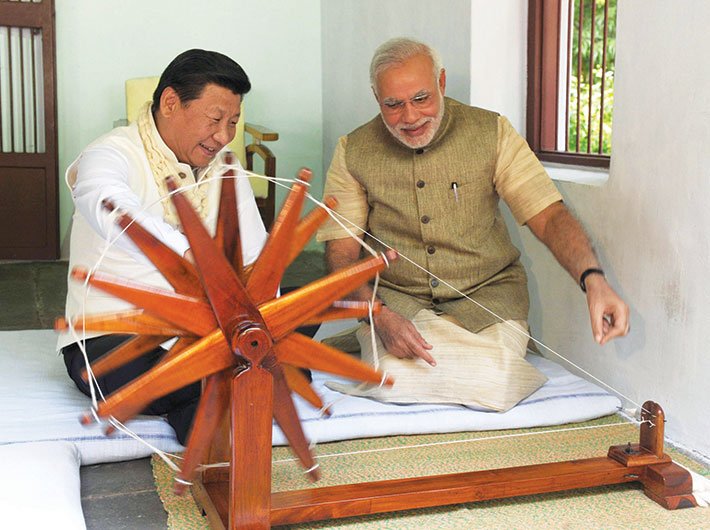Yes, India and China need to work together, but in the red-carpet bonhomie let us not forget the red-flag issues
Prime minister Narendra Modi has a knack for ‘smart’ acronyms and sutras. His latest has touched a chord even with a sceptic like yours truly. As Modi tweeted, the idea of ‘inch’, i.e., India and China, working toward a ‘Millennium of Exceptional Synergy’, i.e. ‘miles’; is certainly an attractive one.
It is indeed important to carry forward the far-sighted initiative taken by Rajiv Gandhi in 1988, when he broke the long diplomatic chill and visited China to meet Deng Xiaoping. The underlying idea of that initiative holds true: the two emerging powers can ‘do business’ and jointly compete for a greater say in world affairs in spite of the pending border dispute.
However, one needs clarity in perspective and consistency in practice to translate such a vision into reality. While we are busy indulging in simplified, in fact, vulgarised remembrance of ‘our’ Kautilya, the Chinese have been learning seriously not only from Confucius, but also from Sun Tzu – the legendary author of the classic, ‘The Art of War’.
PM Modi will do well to be careful about this, as along with having a knack for smart acronyms, he is also quite fond of populist hyperbole. This could well entrap him, at least as far as the Chinese are concerned. It is not for nothing that the ‘inches’ of Mao’s smile or seconds of Deng’s handshake were supposed to carry loads of political message. The Chinese language is written in a script of pictorial characters, and their political message also comes across in a well-crafted visual performance. It was only months ago that then PM-aspirant Modi was lambasting the Congress leadership to go “drown themselves” for praising some Chinese city, even as China continues to hold parts of Indian territory.
Yet, under the watch of now-PM Modi, the Chinese army has continued intruding into Indian territory, even while their president was being hosted in Ahmedabad and New Delhi. What’s more, the Gujarat government reportedly released documents detailing the MoUs signed between the two sides, which depicted Arunachal Pradesh as a disputed territory and Aksai Chin as part of China! There is a message in the continued belligerence from China, just as there is a message in their first lady showering special affection on the students from the northeast during a visit to a Delhi school.
Another point which incidentally emerges from all this is worth considering for the BJP and Modi: it is wise to behave responsibly while in opposition, so that you are credible while in power.
Emphasis on ‘inches’ and ‘miles’ must also lead to getting rid of the undue interest in Pakistan. Indian foreign policy must focus on bigger goals as part of a carefully crafted strategy for the next three or four decades.
The Pakistan obsession stems from two conflicting emotions, which no matter their appeal, are just emotions – be they of the shared past variety, or those of Akhand Bharat fantasies. Parts of north India do have a lot of commonalities with Pakistan, including languages and cuisine, but then north India is not the whole of India, as a seasoned security expert is reported to have had curtly reminded former PM Manmohan Singh.
More importantly, irrespective of commonalities, Pakistan was self-consciously imagined and constructed into a nation-state as an anti-thesis of the idea of India. Jinnah’s pious secular rhetoric after realising his dream did not change the harsh reality of Pakistan being a nation-state essentially rooted in negative propaganda and undemocratic politics. Any political establishment in Pakistan is bound to keep the armed forces in good humour, as has become clear once again from the recent events. The best course for Indian foreign policy in the twenty-first century would be to maintain a working and cautious relationship with Pakistan without investing too much in any Aman ki Asha. It is better to let Pakistan be.
With China, things are more complex. On the one hand, the fact remains that before the current world of nation-states came into being after the Westphalia treaty of 1648, India and China had great civilisational synergy and their insular polities were together dominating the pre-imperialist economic world order. China, like India, has a deep sense of historical destiny of being a guru for the whole world. In fact, in the case of China, this sense is more ingrained in the psyche of the political and intellectual leadership. It is understandable given that the Chinese have longer memories of a centralised polity. It was in China that the idea of a competitive and professional bureaucracy was developed and put to practice centuries before the Europeans thought of such an institution.
Unlike the intellectual leadership in India – some sections of which have traditionally had a sense of gratitude towards their erstwhile imperial masters – the Chinese entertain no such feelings towards those who forcibly turned them into a nation of opium-eaters.
Chinese self-perception and their historical experience have turned them into hard-nosed pragmatists. Under the leadership of Mao, supposedly communist ideals were wedded to an unapologetic Han nationalism.
Sociologist Barrington Moore Jr perceptively remarks, “…the meteoric rise of Maoism demonstrates, [that] the decay of an Asian system of belief and social order has provided fertile soil for the most cruel versions of a search for moral purity.” (Moral Purity and Persecution in History, p. 128). The legacy of the cruel search for moral purity – ‘rule by iron fist’ – continues unabated. China today is a crony capitalist economy, which is politically managed by a centralised nationalist political structure called the Communist Party.
It is this ‘iron fist’ side of the Chinese success story which most fascinates some sections of the Indian business and middle classes and their icons like PM Modi. Such people, in their haste for ‘development’ refuse to see not only the basic differences in the historical experiences (pertaining to colonialism) of these two great civilisations, but also the long-term value of slow but peaceful and democratic social transformation.
However, the fact remains that unlike Pakistan and India, the nation-states of China and India have not been imagined as antithetical to each other, and despite the basic differences in the nature of their respective polities, they indeed share a lot of civilisational yearnings and achievements. In spite of their natural competition for influence, they can also share economic and political interests, as is evident in fora like BRICS.
Yet, it is crucial that Indian policy makers realise that they cannot keep acquiescing to Chinese gestures of hegemony. India’s supplicatory attitude (even if under a 56-incher PM) might earn it a few billions in investment, but will not allow it to be an equal, even if competitive, player for a larger role in the politics and economy of world. If, as news reports indicate, it is indeed true that Kiren Rijiju, minister of state for home, was asked to lie low and not even invited to any official functions in order to please Xi Jinping, it is not only a pathetic kowtowing to the Chinese line on Tibet and Arunachal, but also reflects a lack of clarity at the very top. India must, just like the Chinese, insist through gestures on its own sovereignty. This is sine qua non for any relationship between equals.
By its weak acquiescence to Chinese ‘sensitivity’, the Indian side has given precisely the message which the Chinese want to squeeze out of it.

